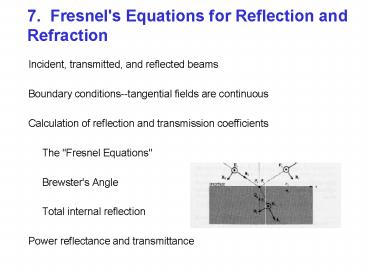7' Fresnel's Equations for Reflection and Refraction - PowerPoint PPT Presentation
1 / 14
Title:
7' Fresnel's Equations for Reflection and Refraction
Description:
transmitted by a flat interface between two media with different refrac- tive indices. ... T Transmitted Power / Incident Power. The (average) power per unit ... – PowerPoint PPT presentation
Number of Views:159
Avg rating:3.0/5.0
Title: 7' Fresnel's Equations for Reflection and Refraction
1
7. Fresnel's Equations for Reflection and
Refraction
- Incident, transmitted, and reflected beams
- Boundary conditions--tangential fields are
continuous - Calculation of reflection and transmission
coefficients - The "Fresnel Equations"
- Brewster's Angle
- Total internal reflection
- Power reflectance and transmittance
2
S and P polarizations
- S polarization is the perpendicular
polarization, and it sticks up out of the plane
of incidence - P polarization is the parallel polarization,
and it lies parallel to the plane of incidence.
3
Fresnel Equations
- We would like to compute the fraction of a light
wave reflected and - transmitted by a flat interface between two media
with different refrac- - tive indices. Fresnel was the first to do this
calculation.
Beam geometry for light with its electric field
per- pendicular to the plane of incidence (i.e.,
out of the page)
4
Boundary Condition for the ElectricField at an
Interface
- The Tangential Electric Field is Continuous
- In other words,
- The total E-field in
- the plane of the
- interface is continuous.
- Here, all E-fields are
- in the z-direction,
- which is in the plane
- of the interface (xz), so
- Ei(x,y0,z,t) Er(x,y0,z,t) Et(x,y0,z,t)
5
Boundary Condition for the MagneticField at an
Interface
- The Tangential Magnetic Field is Continuous
- In other words,
- The total B-field in
- the plane of the
- interface is continuous.
- Here, all B-fields are
- in the xy-plane, so we
- take the x-components
- Bi(x,y0,z,t)cos(qi) Br(x,y0,z,t)cos(qr)
Bt(x,y0,z,t)cos(qt) - It's really the tangential B/µ, but we're using
µ µ0
6
Reflection and Transmission for Perpendicularly
Polarized Light
- Ignoring the rapidly varying parts of the light
wave and keeping - only the complex amplitudes
7
Reflection Transmission Coefficientsfor
Perpendicularly Polarized Light
8
Fresnel EquationsParallel electric field
Beam geometry for light with its electric
field parallel to the plane of incidence (i.e.,
in the page)
- This definition of the reflected electric field
is confusing! - Consider the case of normal incidence (qi 0)...
9
Reflection Transmission Coefficientsfor
Parallel Polarized Light
- For parallel polarized light, B0i B0r
B0t - and E0icos(qi) E0rcos(qr) E0tcos(qt)
- Solving for E0r / E0i yields the reflection
coefficient, r - Analogously, the transmission coefficient, t
E0t / E0i, is - These equations are called the Fresnel Equations
for parallel polarized light.
10
Reflection Transmission Coefficientsfor an
Air-to-Glass Interface
- nair 1 lt nglass 1.5
- Note
- 1. Total reflection at q 90
- for both polarizations
- 2. Zero reflection for parallel
- polarization at 56.3
- "Brewster's angle
- (For different refractive indices, Brewsters
angle will be different.) - 3. Sign idiocy at q 0
Reflect this curve about the q-axis for
alternative definition of r???
11
Reflection Coefficients for a Glass-to-Air
Interface
- nglass 1.5 gt nair 1
- Note
- Total internal reflection
- above the "critical angle"
- qcrit º arcsin(nt / ni)
- (The sine in Snell's Law
- can't be gt 1!)
Reflect this curve about the q -axis for
alternative definition of r
12
Reflectance (R) Transmittance (T)
- Define R º Reflected Power / Incident Power
- T º Transmitted Power / Incident
Power - The (average) power per unit area, the
irradiance, - So
- And
- The factors of n and cos(q) occur in T because
the media - 1) have different velocities of light,
hence the factors of n - 2) have different propagation angles,
hence the factors of cos(q)
13
Reflectance Transmittance for anAir-to-Glass
Interface
Note that R T 1
14
Reflection at normal incidence
- When qi 0,
- and
- For an air-glass interface (ni 1 and nt 1.5),
- R 4 and T 96
- The values are the same, whichever direction the
light travels, from air to glass or from glass to
air. - The 4 has big implications for photography
lenses.































